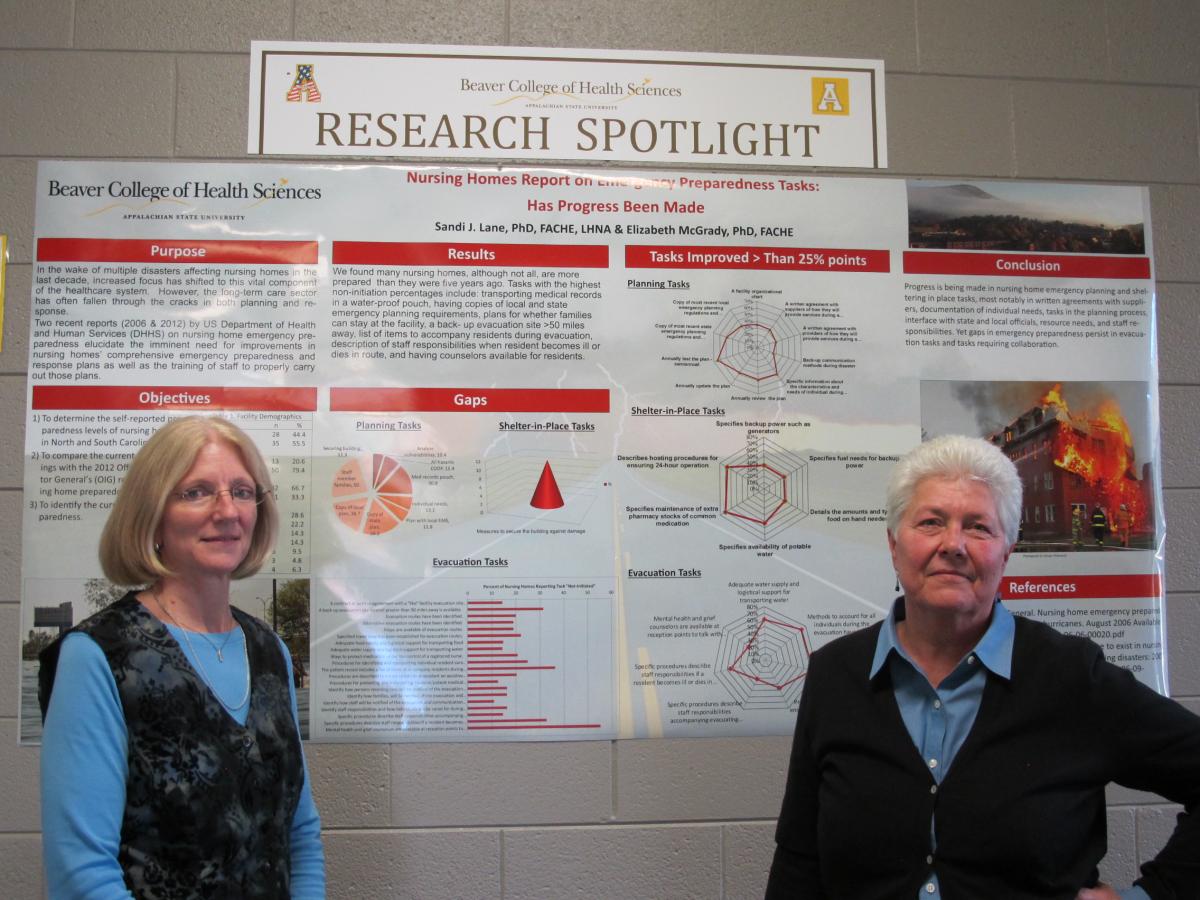
Dr. Sandi Lane (left) and Dr. Elizabeth McGrady.
In the wake of multiple disasters affecting nursing homes in the last decade, and more recently in the aftermath of Hurricanes Harvey and Irma, increased focus has shifted to this vital component of the healthcare system. Sandi J. Lane, Ph.D., FACHE, LHNA and Elizabeth McGrady, Ph.D., FACHE are faculty in the Beaver College of Health Sciences Health Care Management Department and their research focuses on the needs and improvements to nursing homes’ emergency preparedness and response plans, as well as the training of staff to properly carry out those plans.
Disasters can overwhelm a community’s ability to respond and recover, creating a gap between the needs of the community and the resources available to provide services. With recurring gaps in disaster preparedness, efforts to close the gap and improve nursing home preparedness became a focus for nursing home administrators, state healthcare associations, as well as many local, state, and national regulators and legislators. In 2013, the Centers for Medicare and Medicaid Services (CMS) published the proposed rule on emergency preparedness requirements for Medicare and Medicaid participating providers and suppliers, and most recently promulgated these regulations with an implementation date of Nov 15, 2017.
The realization for the need of improved preparedness came for McGrady during Hurricane Katrina. She was working at the University of Dallas at the time and had a grant to help not-for-profit organizations in their training. She had also previously served as a healthcare executive for 13+ years in New Orleans. During Katrina, McGrady’s friends and past co-workers were trapped in the hospital where she used to work. In addition, she assisted Dallas agencies in responding to evacuees relocated to Dallas. It was during this time she realized how healthcare facilities and not-for-profit organizations have a responsibility for disasters and the need for emergency preparedness. Thus, she began working on case studies which have included explosions, fires and flooding in long-term care facilities and nursing homes.
Lane served as a nursing home administrator and experienced several emergency stays due to extreme snowstorms while living in Connecticut, hurricanes in eastern North Carolina, and ice storms in Charlotte. She distinctly remembers when a generator failed to power a unit housing residents who relied on ventilators for life support. Nurses had to manually ventilate the residents until power could be provided to the unit. “These experiences stay with you,” reflected Lane. Living through such disasters are what got her involved in research related to policy and procedures that impact resident care and most recently, disaster related research.
Lane and McGrady’s research focuses on the gaps in emergency preparation, compliance with CMS regulations, and methods to reduce the gaps and improve preparedness. In one recent study they evaluated compliance with a CMS checklist first developed in 2007 as a guide for nursing home emergency preparedness. The three major areas of focus in the checklist of tasks are: overall planning, sheltering-in-place, and evacuation. Although progress has been made since the 2012 Office of Inspector General report on nursing home preparedness, gaps persist in evacuation planning and collaboration with local and state emergency management agencies and other outside agencies. Shelter in Place (SIP) is defined as a protective action strategy taken to maintain resident care in the facility and to limit the movement of residents, staff and visitors in order to protect people and property from a hazard. Past research has shown SIP is preferred over evacuation, yet implementing this option calls for a complex chain of decisions and actions that requires specific pre-event activities including: planning, training, preparation, collaboration, continual vigilance and communication with local authorities. Continued focus on the collaborative aspect of these plans are what will make them successful.
According to Lane, “Unlike hospitals, that are considered a part of the community, nursing homes operate ‘on their own’ mainly due to their ownership types. Hospitals regularly conduct drills and have priority for power restoration, whereas nursing homes are sometimes left to fend for themselves. This is why it is so important for collaboration across all sectors. The relationships and communications between patient care facilities are critical for continued successful care.” The newly promulgated regulations require nursing homes to collaborate with hospitals and emergency management agencies and participate in a community-based full-scale exercise at least annually.
“When evacuation is necessary, premature morbidity and mortality happen with a disaster period, but it is greater with evacuation than with shelter-in-place. Stay until you can’t,” says McGrady. Unfortunately, this has been the case as of late and evacuation is traumatic. Therefore, planning is critical. Of course there are different facilities with different levels of care, but these regulations and planning help to make a level playing field. According to Lane, “When you’re in a disaster, it’s more than the checklist, it’s more than the supplies, it’s more than the plans, it’s the resilience of the people who are working in the facility that makes the difference. These people, their skills and their resilience is what is critical. We need to move towards engagement and collaboration, it can’t be just a checklist that is reviewed. It has to be practiced and implemented. The personal relationships have to be in place, the idea that you need to take care of your neighbor is important in any disaster, but it can also save a life.”
McGrady also stresses the importance of this mindset, “If we really want to improve the outcome, then we need to look beyond checklist type items and move towards what the regulations say, and collaborate with your neighbors, and your community, and practice with them, building that relationship so that when disaster hits and you call for help, there is the appropriate response.”
Lane and McGrady wish for their research to confirm emergency preparedness is continually improving and saving lives, and while these are steps in the right direction, they plan to continue their research in addressing gaps and enhancing collaboration.